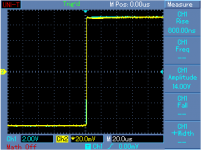The Siemens/EPCOS doc is at
http://www.epcos.com/web/generator/...__en.pdf;/PDF_GeneralTechnicalInformation.pdf
(page 13)
No underlying theory here.
Confusing names.Polyethylene terephthalate (PET) is a polyester. Polyethylene naphthalate (PEN) is a polyester as well.
Polyethylene is a polyolefin, a completely different polymer family.

Only confusing in the sense that sodium and sodium carbonate are confusing names: one is a reactive metal, the other is a white powder which is non-toxic in small quantities.
Anyway, the name is not so important. What is important is the bad frequency behavior of MKN, and not very good behavior of MKT and MFT. John has always been right when recommending polypropylene, polystyrene and teflon. I would add NPO/COG small ceramic caps as well. And the best capacitor is no capacitor.
No underlying theory here.
Company reputable enough for me.
Anyway, the name is not so important.
Except when you're trying to tell a Ph.D. in polymer chemistry that he doesn't know what he's talking about, eh?
se
Company reputable enough for me.
Not the point, the mechanism for "super" capacitance is not clear I can find no references for this behavior and isolating it at or near self-resonance is an interesting problem. Their test circuit would help.
Joan? Is that you?
se
Since this thread is about el. maybe Pano isn't Joan, but a combination of Maxwell and Edison 😀
Maxwell Edison
Cheers
S
Not the point, the mechanism for "super" capacitance is not clear I can find no references for this behavior and isolating it at or near self-resonance is an interesting problem. Their test circuit would help.
??? I could not find a reference that matched "super" capacitance in the pdf.
Some dielectrics are more lossy at higher frequencies. PE as used in cables would make a great cap having good electrical properties to several GHz but the temp problem probably prevents it use as does the difficulty making a usable film from it.
The MKN with the poor cap vs frequency characteristics probably gets very hot at high current RF.
The cap vs. freq. curve just requires a good bridge and its pretty easy to measure.
??? I could not find a reference that matched "super" capacitance in the pdf.
Some dielectrics are more lossy at higher frequencies. PE as used in cables would make a great cap having good electrical properties to several GHz but the temp problem probably prevents it use as does the difficulty making a usable film from it.
The MKN with the poor cap vs frequency characteristics probably gets very hot at high current RF.
The cap vs. freq. curve just requires a good bridge and its pretty easy to measure.
I was refering to things like FDNR's where things look like capacitors varying faster than proportional to f. Less lossy or better (lossy is a resistive component) at higher frequencies I find unusual. If your bridge has a 1MHz test frequency and we resonate the cap at 1MHz with an L you can't measure the C, only the loss.
Last edited:
PMA, it is interesting that Tektronix had a similar problem making their attenuators, and wrote a technical article about it back in the early 1970's. They had problems compensating their attenuators, because of the inherent circuit board DA, which they referred to as 'circuit hook' I'm fairly sure. There was an interesting article in one of the major American electronic engineering magazines, so I would guess 'EDN', 'Electronics Design', or 'Electronics' magazine. Unfortunately, I lost the article in the firestorm, 20 years ago.
- Status
- Not open for further replies.
- Home
- Member Areas
- The Lounge
- John Curl's Blowtorch preamplifier part II
